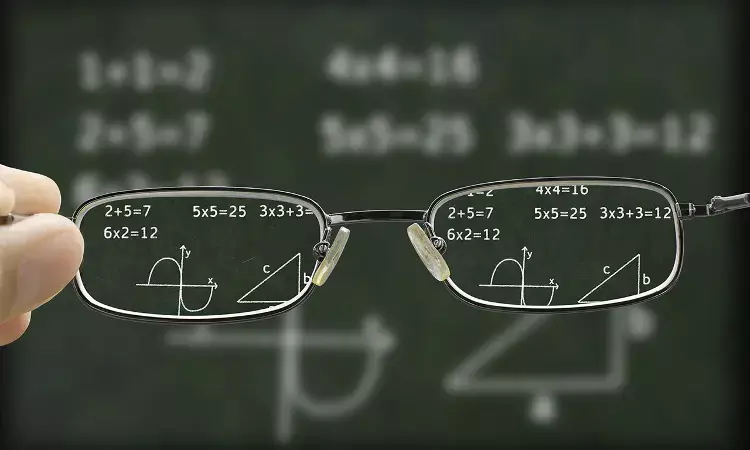- Home
- Medical news & Guidelines
- Anesthesiology
- Cardiology and CTVS
- Critical Care
- Dentistry
- Dermatology
- Diabetes and Endocrinology
- ENT
- Gastroenterology
- Medicine
- Nephrology
- Neurology
- Obstretics-Gynaecology
- Oncology
- Ophthalmology
- Orthopaedics
- Pediatrics-Neonatology
- Psychiatry
- Pulmonology
- Radiology
- Surgery
- Urology
- Laboratory Medicine
- Diet
- Nursing
- Paramedical
- Physiotherapy
- Health news
- Fact Check
- Bone Health Fact Check
- Brain Health Fact Check
- Cancer Related Fact Check
- Child Care Fact Check
- Dental and oral health fact check
- Diabetes and metabolic health fact check
- Diet and Nutrition Fact Check
- Eye and ENT Care Fact Check
- Fitness fact check
- Gut health fact check
- Heart health fact check
- Kidney health fact check
- Medical education fact check
- Men's health fact check
- Respiratory fact check
- Skin and hair care fact check
- Vaccine and Immunization fact check
- Women's health fact check
- AYUSH
- State News
- Andaman and Nicobar Islands
- Andhra Pradesh
- Arunachal Pradesh
- Assam
- Bihar
- Chandigarh
- Chattisgarh
- Dadra and Nagar Haveli
- Daman and Diu
- Delhi
- Goa
- Gujarat
- Haryana
- Himachal Pradesh
- Jammu & Kashmir
- Jharkhand
- Karnataka
- Kerala
- Ladakh
- Lakshadweep
- Madhya Pradesh
- Maharashtra
- Manipur
- Meghalaya
- Mizoram
- Nagaland
- Odisha
- Puducherry
- Punjab
- Rajasthan
- Sikkim
- Tamil Nadu
- Telangana
- Tripura
- Uttar Pradesh
- Uttrakhand
- West Bengal
- Medical Education
- Industry
Repeated low-level red-light therapy lowers myopia onset risk in youngsters: Study

Australia: A new study published in the Ophthalmology journal suggests that repeated low-level red-light (RLRL) therapy at 100% power significantly slowed the onset of myopia in myopic youngsters over the course of six months.
Despite the fact that open-label research has hampered earlier trials, repeated low-level red light therapy is developing as a treatment for controlling myopia. The goal of this study by Jing Dong and colleagues was to evaluate the effectiveness and safety of RLRL treatment in slowing the progression of myopia to a sham device that had just 10% of the original power.
112 Chinese children aged 7 to 12 who had myopia of at least -0.50 D, astigmatism of less than -1.50 D, and anisometropia of less than 1.50 D all took part in this double-blind, randomized, controlled clinical experiment. The RLRL group or the sham device control group, with a three-minute session length each session, twice daily, and a minimum four-hour gap between sessions, was randomly allocated to participants in a 1:1 ratio. Red light treatment was delivered at home using a desktop device. The fake gadget was identical to the real one, except only had 10% of its power. Axial length (AL) and cycloplegic refraction were assessed at baseline and after six months. Generalized estimating equations (GEE) were used to compare changes in cycloplegic spherical equivalence refraction (SER) and AL between the two groups.
The key findings of this study were:
1. 111 kids in all were included for the analysis. In the RLRL group, the mean SER change after 6 months was 0.060.30 D, while in the sham device control group, it was -0.110.33 D.
2. The mean increases in AL were 0.020.11 mm and 0.130.10 mm, respectively. Children in the RLRL group exhibited reduced axial elongation and myopia progression in the multivariate GEE models than children in the sham device control group.
In conclusion, the PI suggested that the RLRL therapy was well tolerated by the youngsters and it had no unfavorable side effects.
Reference:
Dong, J., Zhu, Z., Xu, H., & He, M. (2022). Myopia Control Effect of Repeated Low-Level Red-Light Therapy in Chinese Children: A Randomized, Double-Blind, Controlled Clinical Trial. In Ophthalmology. Elsevier BV. https://doi.org/10.1016/j.ophtha.2022.08.024
Neuroscience Masters graduate
Jacinthlyn Sylvia, a Neuroscience Master's graduate from Chennai has worked extensively in deciphering the neurobiology of cognition and motor control in aging. She also has spread-out exposure to Neurosurgery from her Bachelor’s. She is currently involved in active Neuro-Oncology research. She is an upcoming neuroscientist with a fiery passion for writing. Her news cover at Medical Dialogues feature recent discoveries and updates from the healthcare and biomedical research fields. She can be reached at editorial@medicaldialogues.in
Dr Kamal Kant Kohli-MBBS, DTCD- a chest specialist with more than 30 years of practice and a flair for writing clinical articles, Dr Kamal Kant Kohli joined Medical Dialogues as a Chief Editor of Medical News. Besides writing articles, as an editor, he proofreads and verifies all the medical content published on Medical Dialogues including those coming from journals, studies,medical conferences,guidelines etc. Email: drkohli@medicaldialogues.in. Contact no. 011-43720751


